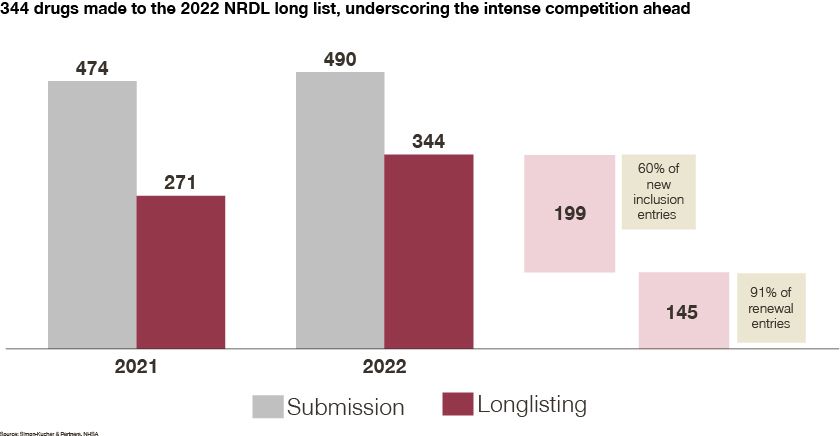China’s 2022 NRDL Outlook
The 2022 National Reimbursement Drug List will see more pressures for new inclusions on the one hand, and more certainties for renewals on the other. At the same time, the process is becoming more interactive and transparent.
Bruce Liu

The first round of the 2022 National Reimbursement Drug List (NRDL) review took longer than expected, partly as a result of the large number of entries submitted. In the first half of July, the National Healthcare Security Administration (NHSA) received applications for 490 drugs, 344 of which passed the formal review to land in the long list in September.

The long list gets longer
199 candidates made the long list for new inclusion this year, an increase of 16% over 2021.
Within the last few years, most of the candidates received China regulatory approvals, around 60 of these were approved within the past 12 months. These include lorlatinib, brigatinib, mepolizumab, and vericiguat, which have been largely in sync with US and EU approvals, as well as olverembatinib and azvudine that made their debuts by being approved in China before other markets.
At the same time, many that failed last year’s NRDL are making a comeback. Some have revamped their strategies and sharpened their focus.
Venclexta, the first target therapy for AML, for example, approached the 2022 NRDL with a new patient assistance program. It did so to signal its commitment for access. More importantly, however, it furnished its application with more emphasis on its clinical, patient, and socio-economic value, highlighting its innovative nature by declaring no comparator in its formal review material.
Of the six categories for new inclusion, pediatric and rare disease drugs were singled out for 2022, with 11 and 19 entries making it to the long list. This echoes the government’s ongoing moves to improve healthcare equity for all and hints more attention and priority for making the next rounds.
Of particular interest in the rare disease candidates are four high-priced enzyme replacement therapies from Sanofi, including Cerezyme, Myozyme, Aldurazyme, Fabrazyme, and Takeda’s Vpriv which will be pitted against Cerezyme. In addition, inebilizumab for NMOSD and siltuximab for Castleman disease are among the latest entries submitted by local biopharma companies, indicating a notable shift in China’s rare diseases paradigm.
Better predictability for NRDL renewals
Thanks to the latest changes to NRDL rules, 145 drugs are up for NRDL renewal and will benefit from more transparencies and certainties.
Past renewal regulations will be subject to renegotiation triggers, such as indication expansions and competitive landscape changes. The 2022 NRDL, on the other hand, clarified that as long as past and future budget impacts are within 200% and 100% of revenue estimates, a standard price adjustment algorithm would be followed barring severe international reference pricing (IRP) and competitive impacts.
This marks a major improvement for candidates to predict and forecast price expectations. It also allows the NHSA to minimize the need for renegotiations, which could be arbitrary and time consuming in the past.
More time pressure
The renewal rule change is a timely and much welcomed one, especially as the 2022 NRDL timeline is much more squeezed in comparison to past years.
The current plan is to release the final results in November, leaving only two months for the next stages, i.e., comprehensive expert reviews for short listing, followed by cost-effectiveness assessments and budget impact analyses, ending with a final showdown with negotiation experts.

The added time pressure, coupled with the budget pressure as a result of ongoing spending on COVID vaccines and testing on a national scale, will make 2022 an unusual year for the NRDL and everyone in the game.
Pharma companies will need to buckle up for the coming months as the process unfolds. Be prepared for different scenarios at shortlisting, pharmacoeconomic modeling, and price negotiations, to make the best out of the roller coaster ride ahead.
Changes for the better
The good news is that there are a few windows built in this year’s process for engagement, communication, and appeals with stakeholders as needed. This makes the 2022 NRDL more interactive and transparent than ever before, signaling positive changes for the high-stake game that is both exciting and exasperating for many.
About the authors:
Bruce Liu leads Simon-Kucher’s Life Sciences division in Greater China. Ivy Jiang, Shiying He and Duo Xu are senior consultants with extensive experience in China market access and reimbursement trends.